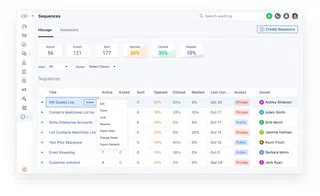Got questions? find answers!
What is a sales sequence and how does it work?
A sales sequence is a series of automated, pre-scheduled actions within a CRM (Customer Relationship Management) system aimed at nurturing leads through the sales process. This sequence may include sending personalized emails, text messages, and reminders for follow-up activities. By automating these steps, sales teams can maintain consistent outreach to leads and ensure that no critical touchpoints are missed.
Why should I use a sales sequence in my CRM?
Sales sequences simplify the process of engaging with prospects by eliminating the need for manual follow-ups. With a CRM system, you can automate communications to ensure timely and consistent outreach. This automation enhances lead conversion, saves valuable time, and prevents any opportunities from being overlooked, allowing your sales team to concentrate on more strategic tasks.
How can I automate my sales sequence with email and text messages?
Customer Relationship Management (CRM) systems like Salesmate provide convenient pre-built options for automating email and text communications within your sequences. To get started, simply design your multi-step sequence by outlining the desired number of days between each step and specifying the timing for each communication. Once you set that up, you can sit back and let the CRM take care of the rest, ensuring a smooth and efficient outreach process.
What are the benefits of using sales cadences in CRM for follow-ups?
Sales cadences are essential for automating follow-ups in CRM systems. They guarantee that each lead is contacted at the appropriate time, eliminating the need for manual tracking. By implementing a sales cadence, you can nurture leads through multiple steps, customizing your messaging based on their behavior, which significantly boosts the chances of closing deals. Consistent follow-ups also help strengthen relationships with prospects.
How can sales sequences improve my lead conversion rate?
Sales sequences help improve lead conversion rates by ensuring that follow-ups are timely, relevant, and personalized. When leads receive consistent, well-timed communication, they are more likely to engage with your sales team. Automation also ensures that no leads are neglected and follow-ups occur at optimal points in the buyer’s journey, improving the likelihood of conversions.
What are the best practices for setting up effective sales sequences?
For an effective sales sequence, aim for 5-7 steps over 10-20 days. Start with an email introduction, followed by a text message reminder, and continue alternating between emails, texts and calls. Use email for detailed information and text for quick, attention-grabbing follow-ups. Personalize each message, ensure clear calls to action, and regularly test and optimize your sequence for better performance.



















